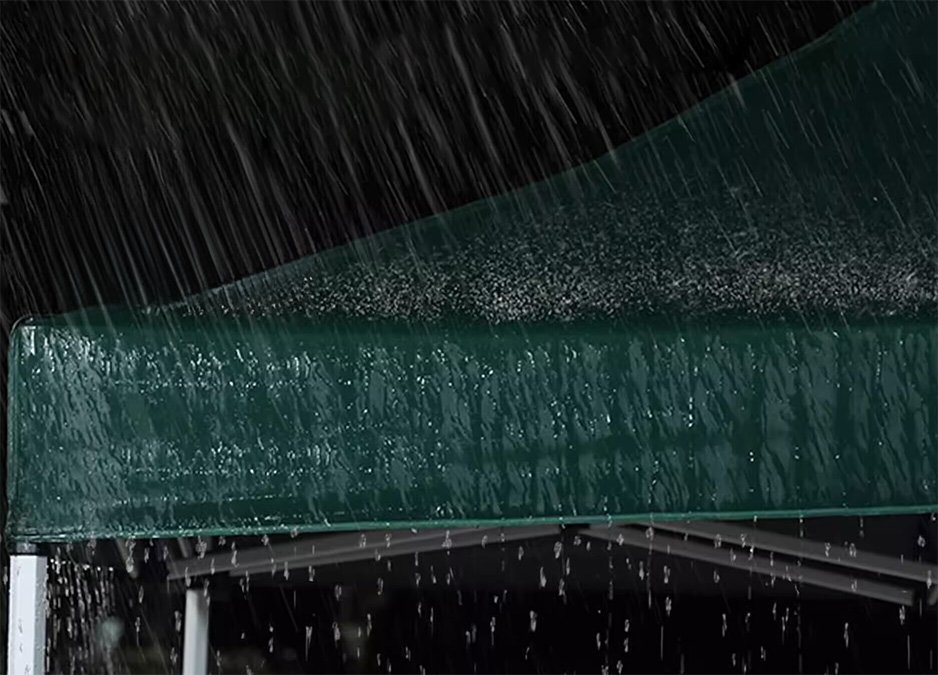Knowledge
Are Custom Canopy Tents Waterproof?
When it comes to choosing a custom canopy tent, one of the most critical factors to consider is whether it will keep you dry during unpredictable weather conditions. Custom canopy tents are often made from polyester or nylon fabrics, known for their tightly woven structure.
However, not all canopy tents offer the same level of water protection. Understanding the difference between waterproof and water-resistant fabrics is crucial in making an informed decision.
Waterproof vs. Water-Resistant: What’s the Difference?
The terms “waterproof” and “water-resistant” are frequently used interchangeably, but they have distinct meanings when it comes to canopy tents.
Water-Resistant Canopy: Water-resistant fabrics are designed to repel water to a certain extent. These materials often have a hydrophobic coating applied to their surface, making it difficult for water to penetrate or soak through completely.
While water-resistant canopies can withstand light rain and splashes, prolonged exposure to heavy rain can eventually cause water to seep through the fabric. Over time, the effectiveness of the hydrophobic coating may diminish, reducing the fabric’s ability to repel water.
Waterproof Canopy: Waterproof fabrics, on the other hand, are engineered to prevent water from passing through entirely.
This is typically achieved by applying a layer of PVC resin to the backside of the fabric through processes like rolling or dipping, followed by drying and curing to ensure a durable bond. A waterproof canopy is designed to keep you dry even during heavy and prolonged rain.
Waterproof Rating

The waterproof rating of a tent fabric is often measured by its “waterhead” or “hydrostatic head.” This rating indicates the amount of water pressure the fabric can withstand before it starts to leak. Essentially, it measures the fabric’s resistance to water penetration.
To break it down:
- 0-1000mm: Water-resistant, suitable for light rain.
- 1000-1500mm: Waterproof, can handle moderate rain.
- 1500-5000mm: Very waterproof, capable of withstanding heavy rain.
- 5000-10000mm: Highly waterproof, designed for extreme weather conditions.
For instance, a 600D PVC Oxford fabric with a waterhead rating of 6000mm or higher is highly waterproof and suitable for severe weather.
It’s important to note that the waterproof rating only refers to the fabric’s ability to resist water penetration.
It doesn’t necessarily reflect the overall quality or durability of the fabric, nor does it account for the tent’s seam construction, which is also a crucial factor in preventing water ingress.
Is Waterproof Fabric Completely Waterproof?

Even with waterproof fabrics, rainwater can still find its way inside a canopy tent through the seams. Therefore, it’s essential to look for canopies with sealed seams. Heat-sealed tape is commonly used to cover the seams, providing an additional layer of protection against water infiltration.
Other Considerations for Waterproof Canopy Tents
When selecting a custom canopy tent, consider the following tips to enhance its waterproof capabilities:
- Seam Sealing: Ensure that the tent’s seams are sealed with heat-sealed tape to prevent water from entering through the stitching holes.
- Proper Setup: Make sure the canopy is set up correctly with taut fabric to prevent water pooling and sagging.
- Additional Accessories: Use additional accessories like sidewalls and gutters to further protect against rain.
- Maintenance: Regularly maintain and reapply waterproof coatings as needed to ensure continued water resistance.
Conclusion
In conclusion, while custom canopy tents can be made from water-resistant or waterproof fabrics, understanding the differences between the two is essential.
Water-resistant canopies offer limited protection and are suitable for light rain, whereas waterproof canopies provide more robust protection against heavy rain.
The waterproof rating, measured by the hydrostatic head, gives an indication of the fabric’s ability to withstand water pressure. Additionally, ensuring that seams are properly sealed and following proper maintenance practices can enhance the tent’s overall water resistance.
When choosing a custom canopy tent, consider your specific needs and the weather conditions you are likely to encounter. By selecting the right fabric and ensuring proper setup and maintenance, you can stay dry and comfortable, no matter the weather.
